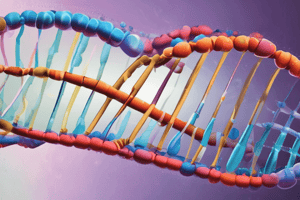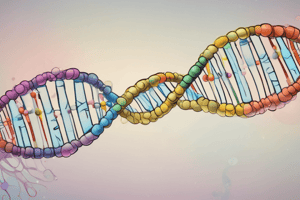Podcast
Questions and Answers
During DNA replication, which enzyme is responsible for unwinding the double helix?
During DNA replication, which enzyme is responsible for unwinding the double helix?
- Ligase
- DNA polymerase
- Topoisomerase
- Helicase (correct)
What is the primary function of mRNA in gene expression?
What is the primary function of mRNA in gene expression?
- To synthesize proteins
- To carry genetic information from DNA to the ribosome (correct)
- To transport amino acids
- To regulate gene expression
What is the purpose of gene editing in genetic engineering?
What is the purpose of gene editing in genetic engineering?
- To introduce new traits into an organism
- To clone a gene
- To alter the sequence of a gene (correct)
- To produce recombinant proteins
During protein synthesis, what occurs during the elongation stage?
During protein synthesis, what occurs during the elongation stage?
What is the process by which cells heritably change gene function without changing the underlying DNA sequence?
What is the process by which cells heritably change gene function without changing the underlying DNA sequence?
What type of RNA is involved in carrying amino acids during protein synthesis?
What type of RNA is involved in carrying amino acids during protein synthesis?
What is the primary function of histone modification in epigenetics?
What is the primary function of histone modification in epigenetics?
What is the result of DNA methylation in epigenetics?
What is the result of DNA methylation in epigenetics?
What is the term for the study of heritable changes in gene function that occur without a change in the underlying DNA sequence?
What is the term for the study of heritable changes in gene function that occur without a change in the underlying DNA sequence?
What is the final stage of protein synthesis, where the completed protein is released?
What is the final stage of protein synthesis, where the completed protein is released?
Flashcards are hidden until you start studying
Study Notes
DNA Replication
- Process: The creation of two identical copies of DNA from one original DNA molecule
- Steps:
- Initiation: Unwinding of DNA at origin of replication, binding of helicase and topoisomerase
- Unwinding: Separation of DNA strands, creation of replication fork
- Synthesis: Leading strand synthesis continuous, lagging strand synthesis in short, discontinuous segments (Okazaki fragments)
- Elongation: Addition of nucleotides to leading strand, RNA primers removed and replaced with DNA
- Ligation: Sealing of gaps between Okazaki fragments
- Enzymes involved: Helicase, topoisomerase, primase, DNA polymerase, ligase
Gene Expression
- Definition: The process by which the information in a gene's DNA is converted into a functional product (protein or RNA)
- Steps:
- Transcription: Synthesis of RNA from DNA template
- Translation: Synthesis of protein from RNA sequence
- Regulation: Gene expression is regulated at multiple levels, including transcriptional, post-transcriptional, and post-translational
- Types of RNA: mRNA (messenger), tRNA (transfer), rRNA (ribosomal), miRNA (micro), siRNA (small interfering)
Genetic Engineering
- Definition: The manipulation of an organism's genome using biotechnology
- Techniques:
- Recombinant DNA technology: Creation of recombinant DNA molecules by combining DNA from different sources
- Gene cloning: Creation of multiple copies of a gene
- Gene editing: Alteration of a gene's sequence using CRISPR-Cas9 or other methods
- Applications: Production of recombinant proteins, gene therapy, genetically modified organisms (GMOs)
Protein Synthesis
- Definition: The process by which cells create proteins
- Steps:
- Initiation: Binding of ribosome to mRNA, recognition of start codon
- Elongation: Addition of amino acids to growing polypeptide chain
- Termination: Recognition of stop codon, release of completed protein
- Components: mRNA, ribosomes, tRNA, amino acids
- Types of RNA involved: mRNA, tRNA, rRNA
Epigenetics
- Definition: The study of heritable changes in gene function that occur without a change in the underlying DNA sequence
- Mechanisms:
- DNA methylation: Addition of methyl groups to DNA, typically silencing gene expression
- Histone modification: Addition of various chemical groups to histone proteins, affecting chromatin structure and gene expression
- Inheritance: Epigenetic changes can be passed on to daughter cells, but may not be stable across generations
- Role in development and disease: Epigenetic changes play a crucial role in cellular differentiation and development, and have been implicated in various diseases, including cancer.
DNA Replication
- The process creates two identical copies of DNA from one original DNA molecule
- Initiation involves unwinding of DNA at origin of replication, binding of helicase and topoisomerase
- Unwinding results in separation of DNA strands, creation of replication fork
- Leading strand synthesis is continuous, while lagging strand synthesis occurs in short, discontinuous segments (Okazaki fragments)
- Elongation involves addition of nucleotides to leading strand, RNA primers removed and replaced with DNA
- Ligation seals gaps between Okazaki fragments
- Helicase, topoisomerase, primase, DNA polymerase, and ligase are the enzymes involved
Gene Expression
- Gene expression is the process by which the information in a gene's DNA is converted into a functional product (protein or RNA)
- Transcription involves synthesis of RNA from DNA template
- Translation involves synthesis of protein from RNA sequence
- Gene expression is regulated at multiple levels, including transcriptional, post-transcriptional, and post-translational
- There are five types of RNA: mRNA (messenger), tRNA (transfer), rRNA (ribosomal), miRNA (micro), and siRNA (small interfering)
Genetic Engineering
- Genetic engineering is the manipulation of an organism's genome using biotechnology
- Recombinant DNA technology creates recombinant DNA molecules by combining DNA from different sources
- Gene cloning creates multiple copies of a gene
- Gene editing involves alteration of a gene's sequence using CRISPR-Cas9 or other methods
- Applications include production of recombinant proteins, gene therapy, and genetically modified organisms (GMOs)
Protein Synthesis
- Protein synthesis is the process by which cells create proteins
- Initiation involves binding of ribosome to mRNA, recognition of start codon
- Elongation involves addition of amino acids to growing polypeptide chain
- Termination involves recognition of stop codon, release of completed protein
- mRNA, ribosomes, tRNA, and amino acids are the components involved
- mRNA, tRNA, and rRNA are the types of RNA involved
Epigenetics
- Epigenetics is the study of heritable changes in gene function that occur without a change in the underlying DNA sequence
- DNA methylation adds methyl groups to DNA, typically silencing gene expression
- Histone modification involves addition of various chemical groups to histone proteins, affecting chromatin structure and gene expression
- Epigenetic changes can be passed on to daughter cells, but may not be stable across generations
- Epigenetic changes play a crucial role in cellular differentiation and development, and have been implicated in various diseases, including cancer
Studying That Suits You
Use AI to generate personalized quizzes and flashcards to suit your learning preferences.




